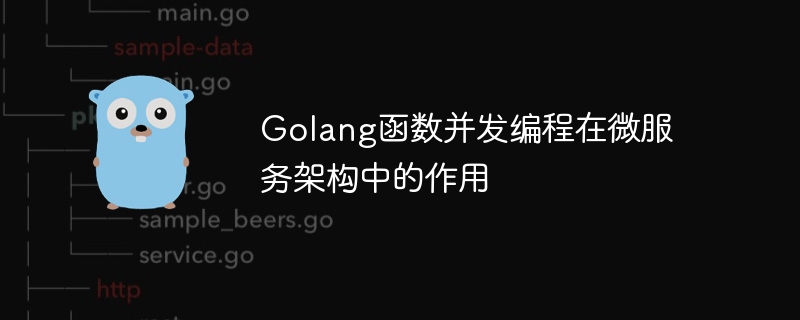Home >Backend Development >Golang >The role of Golang function concurrent programming in microservice architecture
The role of Golang function concurrent programming in microservice architecture
- WBOYWBOYWBOYWBOYWBOYWBOYWBOYWBOYWBOYWBOYWBOYWBOYWBOriginal
- 2024-04-17 13:42:011102browse
In the microservice architecture, the function concurrent programming of Go language is crucial, which uses Goroutine and Channel to implement concurrent task execution. Goroutines are lightweight threads that can execute tasks in parallel, while Channels are used for communication and synchronization between Goroutines. This concurrent programming mechanism brings the benefits of increased throughput, lower latency, and enhanced scalability. Practical cases demonstrate how to use Go language Goroutine and Channel to implement concurrent programming in microservices and further improve performance by caching calculation results.

The role of Go language function concurrent programming in microservice architecture
Introduction
In microservice architecture, function concurrent programming is Key technologies for achieving high throughput and low latency. The Goroutine and channel mechanisms of the Go language provide developers with powerful concurrent programming tools.
Golang Goroutine
Goroutine is a lightweight thread in the Go language, used to execute tasks concurrently. They have the following characteristics:
- Very lightweight, lightweight threads have very little overhead.
- Parallel execution, unlike traditional threads, Goroutine can execute concurrently, thereby improving efficiency.
- Managed by the Go language scheduler.
Golang Channel
Channel is a pipeline in the Go language used to communicate and synchronize Goroutines. They allow Goroutines to send and receive values.
Concurrent programming in microservices
In microservice architecture, concurrent programming can bring the following benefits:
- Improving throughput, Goroutine can process requests in parallel , thereby improving overall throughput.
- Reduce latency. By fully utilizing multi-core CPUs, Goroutine can reduce task execution time.
- Improve scalability, making it easier to add and remove server instances to meet changes in demand.
Practical Case
The following is a practical case using the Go language Goroutine and Channel to implement microservice concurrent programming:
package main
import (
"context"
"fmt"
"net/http"
"sync"
"github.com/golang/protobuf/ptypes"
)
// 定义 gRPC 服务接口
type MyService interface {
DoSomething(ctx context.Context, req *MyRequest) (*MyResponse, error)
}
// 实现 gRPC 服务
type myService struct {
mutex sync.Mutex
// 缓存结果
cache map[string]*MyResponse
}
func (s *myService) DoSomething(ctx context.Context, req *MyRequest) (*MyResponse, error) {
s.mutex.Lock()
defer s.mutex.Unlock()
// 从缓存中获取结果
resp, ok := s.cache[req.Id]
if !ok {
// 如果缓存中没有,则计算结果
resp = &MyResponse{
Id: req.Id,
Value: fmt.Sprintf("Hello, %s!", req.Name),
}
// 缓存结果
s.cache[req.Id] = resp
}
// 将 gRPC Timestamp 转换为 Go 语言时间
resp.Timestamp, _ = ptypes.TimestampProto(time.Now())
return resp, nil
}
func main() {
// 创建 gRPC 服务器
s := grpc.NewServer()
// 注册 gRPC 服务
MyService.RegisterMyServiceServer(s, &myService{})
// 启动 gRPC 服务器
s.Serve(lis)
}In the above example, the microservice Use Go language Goroutine to process requests concurrently. Each request is executed by a separate Goroutine, maximizing throughput and reducing latency. Additionally, it uses Channels to cache calculation results, further improving performance.
The above is the detailed content of The role of Golang function concurrent programming in microservice architecture. For more information, please follow other related articles on the PHP Chinese website!

